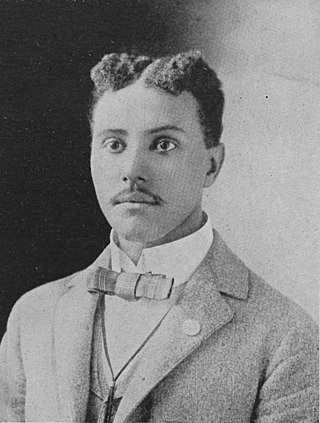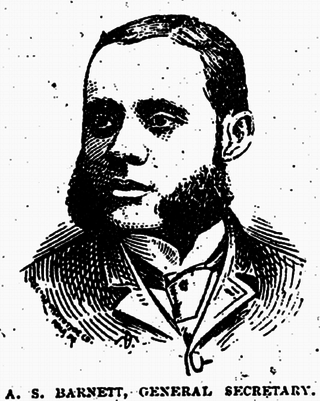Related Research Articles
The Bethel Literary and Historical Society was an organization founded in 1881 by African Methodist Episcopal Church Bishop Daniel Payne and continued at least until 1915. It represented a highly significant development in African-American society in Washington, D.C. Most of its early members were members of the Metropolitan AME Church where its meetings were held, while maintaining an open invitation for black Washingtonians from across the city. It immediately developed into the preeminent debating society and forum for racial issues in Washington, D.C. The prospect of a separation of schools for black children was heatedly debated in 1881–82 as were the ideas of Booker T. Washington and W. E. B. Du Bois in 1903. It was one of the stops of ʻAbdu'l-Bahá's journeys to the West.
Harrison J. Pinkett was a journalist and civil rights activist in Washington DC and then a lawyer in Omaha, Nebraska. As a journalist, he was the head of the so-called "Press Bureau" and often used the bureau's collective pen name, "P.S. Twister". In 1907, at the recommendation of friends in the NAACP, he moved to Omaha where he frequently worked in civil rights. He served as a first lieutenant in the 92nd Infantry Division in World War I and frequently defended the rights of black soldiers.

Lafayette M. Hershaw was a journalist, lawyer, and a clerk and law examiner for the General Land Office of the United States Department of the Interior. He was a key intellectual figure among African Americans in Atlanta in the 1880s and in Washington, D.C., from 1890 until his death. He was a leader of the intellectual social groups in the capital such as Bethel Literary and Historical Society and the Pen and Pencil Club. He was a strong supporter of W. E. B. Du Bois and was one of the thirteen organizers of the Niagara Movement, the forerunner to the NAACP. He was an officer of the D.C. Branch of the NAACP from its inception until 1928. He was also a founder of the Robert H. Terrell Law School and served as the school's president.
Millard Filmore Singleton was an early black political leader and civil servant in Omaha Nebraska. He was an officer in the Omaha Colored Republican Club and the Omaha branch of the National Afro-American League. He held posts as Justice of the Peace, storekeeper in the United States Internal Revenue Service, recorder of deeds for the city, and as bailiff of the municipal court.
John Albert Williams was a minister, journalist, and political activist in Omaha, Nebraska. He was born to an escaped slave and spoke from the pulpit and the newspapers on issues of civil rights, equality, and racial harmony. He was a highly respected minister, journalist, and civic leader. He served on many committees and boards among Omaha's black community and in the Omaha and Nebraska Episcopal Church.

Richard W. Thompson was a journalist and public servant in Indiana and Washington, D.C. He was at various times an editor or managing editor of the Indianapolis Leader, the Indianapolis World, the Indianapolis Freeman and the Washington D.C. Colored American. He was published as a general correspondent in The Colored American, The Washington Post, the Indianapolis Freeman, the Indianapolis World, Atlanta Age, Baltimore Afro-American Ledger, the Cincinnati Rostrum, the Charleston West Virginia Advocate, the Philadelphia Tribune and the Chicago Monitor. His longest-lasting relationship was with the Indianapolis Freeman. In 1896, the black paper, The Leavenworth Herald, edited by Blanche Ketene Bruce, called Thompson the "best newspaper correspondent on the colored press."
Thomas P. Mahammitt was a journalist, caterer, civil rights activist, and civic leader from Omaha Nebraska. He was owner and editor for the black weekly, The Enterprise, Omaha's leading black paper at the turn of the 20th century. He was also an active leader in the Masons and the Boy Scouts and was named "Omaha's most distinguished Negro citizen" in 1934.

Ella Lillian Davis Browne Mahammitt was an American journalist, civil rights activist, and women's rights activist from Omaha, Nebraska. She was editor of the black weekly The Enterprise, president of Omaha's Colored Women's Club, and an officer of local branches of the Afro-American League. On a national stage, in 1895 she was vice-president of the National Federation of Afro-American Women, headed by Margaret James Murray, and in 1896 was a committee member of the successor organization, the National Association of Colored Women, under president Mary Church Terrell.

Edwin R. Overall aka Edwin R. Williams was an abolitionist, civil rights activist, civil servant, and politician in Chicago and Omaha. In the 1850s and 1860s, he was involved in abolition and underground railroad activities headed at Chicago's Quinn Chapel AME Church. During the U. S. Civil War, he recruited blacks in Chicago to join the Union Army. After the war, he moved to Omaha, where he was involved in the founding of the National Afro-American League and a local branch of the same. He was the first black in Nebraska to be nominated to the state legislature in 1890. He lost the election, but in 1892, his friend Matthew O. Ricketts became the first African-American elected to the Nebraska legislature. He was also a leader in Omaha organized labor.
Cyrus Dicks Bell was a journalist, civil rights activist, and civic leader in Omaha, Nebraska. He owned and edited the black newspaper Afro-American Sentinel during the 1890s. He was an outspoken political independent and later in his life became a strong supporter of Democrats. He was a founding member of the state Afro-American League and frequently spoke out against lynchings and about other issues of civil rights.

Alfred S. Barnett was an American journalist and civil rights activist in Omaha, Nebraska, Des Moines, Iowa, and Chicago, Illinois. In Des Moines, Barnett created and ran the newspaper, The Weekly Avalanche from 1891 to 1894. Before moving to Des Moines, he contributed to his brother, Ferdinand L. Barnett's Omaha paper, The Progress. He worked for civil rights also a member and an officer of numerous civil rights organizations, including the Nebraska branch of the National Afro-American League and the Afro-American Protective Association of Iowa. Barnett was described as a "pleasing speaker".
George F. Franklin was a journalist and civic leader in Omaha, Nebraska, and Denver, Colorado. He owned and published two African-American newspapers, The Enterprise in Omaha and The Star in Denver. He was active in civil rights and was a member of the Nebraska branch of the National Afro-American League.

The history of African-Americans in Omaha in the 19th Century begins with "York", a slave belonging to William Clark of the Lewis and Clark Expedition who came through the area in 1804, before the city existed. African-Americans have lived in the Omaha area since at least 1819, when fur traders lived in the area.

Alphonso Wilson was an African-American activist in Omaha, Nebraska at the turn of the 20th century. Wilson was born in Bedford, Missouri in 1860. In 1880 he moved to Chicago and in 1886 he moved to Omaha. In Omaha he was a partner of the real estate firm Wilson & Bryant with James Bryant. In 1890 he was elected the Chairman of the Bureau of Immigration of the Nebraska branch of the National Afro-American League under president Matthew Ricketts. He also served as treasurer and a founding member of the Omaha Union League club, a social club and lyceum formed in 1895. In 1890, he was a member of a national building, loan, and protective union organized to assist Omaha blacks to buy or build a home. The local board of the group consisted of president George F. Franklin, vice president William Marshall, Secretary and Treasurer Alfred S. Barnett and Attorney James S. Bryant. The Board of Appraisers was Millard F. Singleton, Alphonso Wilson, and Harrison Buckner.
James S. Bryant was a journalist and civil rights activist in Omaha, Nebraska. He worked with Ferdinand L. Barnett on his paper, The Progress in the 1890s.
Emmanuel S. Clenlans was a civil rights activist and postal worker in Omaha, Nebraska. Clenlans was born in about 1841 in Washington, DC. He married a woman named Ophelia and they had a daughter named Laura.
William R. Gamble was a civil rights activist and barber in Lincoln, Nebraska and Omaha, Nebraska. Gamble was born a slave in Mobile, Alabama in about 1850. His wife, Eveline, had French-Canadian and Native American ancestry. They were married in Lincoln, Nebraska in 1873 and moved to Omaha, Nebraska around 1880. They had eight children. Gamble's oldest daughter Lucinda became Omaha's first black school teacher and eventually married Father John Albert Williams, serving as an active community leader in North Omaha throughout her life. His other children were William, Richard Joseph, Edward, Leonard, Fred, Mary, and George. Gamble died on April 16, 1910.

Robert Heberton Terrell was an attorney and the second African American to serve as a justice of the peace in Washington, DC. In 1911 he was appointed as a judge to the District of Columbia Municipal Court by President William Howard Taft; he was one of four African-American men appointed to high office and considered his "Black Cabinet". He was reappointed as judge under succeeding administrations, including that of Democrat Woodrow Wilson.

Freeman H. M. Murray was an intellectual, civil rights activist, and journalist in Washington D.C. and Alexandria, Virginia. He was active in promoting black home-ownership, opposing Jim Crow laws and lynching, and supporting positive representation of African Americans in public art. He was a founding member of the Niagara Movement and was an editor of its journal, the Horizon, along with W. E. B. Du Bois and Lafayette M. Hershaw. Alongside his other work, Murray was an important intellectual leader and wrote an influential book of art criticism. In this, Murray was one of the first historians of African American art. His work expressed a desire that art take seriously the representation of African Americans and that slavery not be overlooked in favor of representation of heroes and glory in public art.
Henry Vinton Plummer, Jr. was an American lawyer, real estate agent, civil rights activist, and black nationalist. In the 1920s he became involved in Marcus Garvey's Universal Negro Improvement Association and African Communities League (UNIA), leading the organizations publicity and propaganda wings, Garvey's secret service, and its militia.
References
- 1 2 3 "Deaths". Evening Star (Washington (DC), District of Columbia). Monday, July 3, 1933. Page: 8
- ↑ "The Week in Society". Washington Bee (Washington (DC), District of Columbia). Saturday, June 19, 1909. Volume: XXX Issue: 3 Page: 5
- ↑ "Colored Men in Session Nebraska's Representative Negroes Meet and Form a State Afro-American League". Omaha World-Herald (Omaha, Nebraska). Thursday, May 1, 1890. Volume: XXV Issue: 212 Page: 5
- 1 2 "No Headline". Washington Bee (Washington (DC), District of Columbia). Saturday, December 17, 1898. Volume: XVII Issue: 30 Page: 4
- ↑ "The Week in Society". Washington Bee (Washington (DC), District of Columbia). Saturday, October 3, 1908. Volume: XXIX Issue: 18 Page: 5
- ↑ "No Headline". Washington Bee (Washington (DC), District of Columbia). Saturday, January 2, 1909. Volume: XXIX Issue: 32 Page: 8
- ↑ "Business League Installs Officers House Warming of the Omega Psi Phi Fraternity, of Howard University". Freeman (Indianapolis, Indiana). Saturday, January 17, 1914. Page: 1
- ↑ "News from Washington D. C.". Savannah Tribune (Savannah, Georgia). Saturday, January 20, 1917. Volume: XXXII Issue: 20 Page: 8
- ↑ "Colored Organization Holds Annual Meeting". Evening Star (Washington (DC), District of Columbia). Monday, April 21, 1919. Page: 10
- ↑ "Offers Bill To Abolish The "Jim Crow" Car". Washington Bee (Washington (DC), District of Columbia). Saturday, March 8, 1919 Page: 3
- ↑ "Officers Banneker Relief Association". Washington Bee (Washington (DC), District of Columbia). Saturday, December 19, 1908. Volume: XXIX Issue: 30 Page: 5